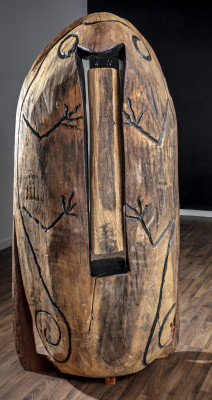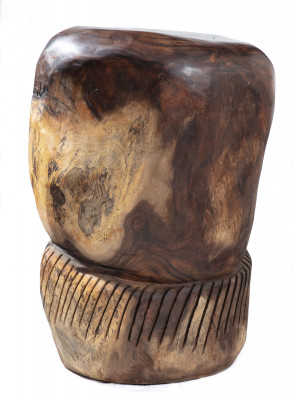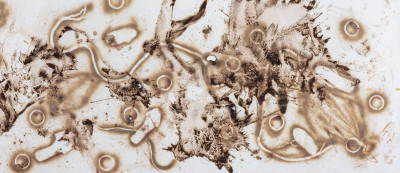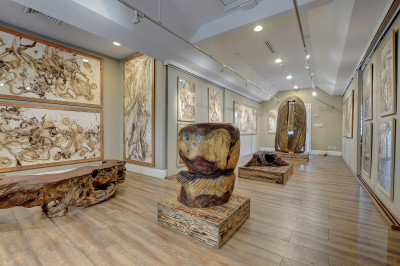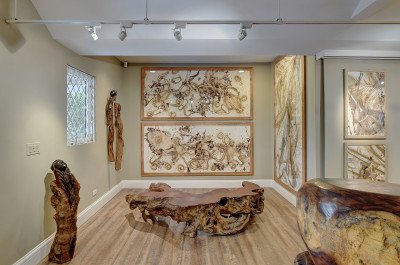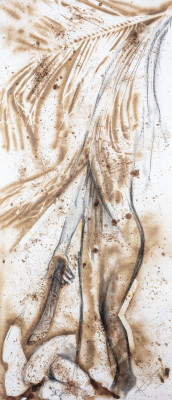Resilient
04/18/2024-06/15/2024
I seek to engage in the preservation of history, traditions, and indigenous materials that are woven into the fabric of our story. - Antonius Roberts
We are delighted to announce our first solo exhibition with Bahamian artist, Antonius Roberts OBE. Roberts is a mixed media artist, primarily known for his work with wood sculpture and installation, and for conceptualising and running collective and socially engaged art projects. His practice reflects on ecology, black portraiture and self-expression as a method of de-colonization. In this exhibition, Roberts will unveil sculptures made with found and felled silk-cotton, madeira, logwood, lignum vitae and woman’s-tongue. He carves into the trees or logs to find and draw-out figurative characteristics and then uses the dust and remnants created through the activity of carving to create large-scale, expressive drawings.
Roberts’ interest in ecology is communicated through his careful handling of material; before making any marks or cuts, the origin of finding or being gifted the wood becomes integrated into the artwork’s narrative. When Roberts was given material from a wrecked Haitian Sloop, he conceptualised an artwork entitled Ceremonial stools in honour of Haitians that have died while attempting to cross the ocean. The installation is quiet but monumental: 5 bare and simple stools hang on the wall in a row. Ceremonial Stools, like all of Roberts’ sculptures, are carefully and minimally reworked, resulting in artworks that hang in-balance between living tree and sculpture. Bodies and objects emerge from the wood at certain angles and retreat at others. When confronting his works for the first time, you might find yourself, as I did, engaging in a kind of lunar pareidolia (seeking the man in the moon), wondering out loud, “is this a Chickcharney? Is this a thumb or a hand?”. The glimpses of something recognizable recall the experience of seeing an apparition or spirit in the corner of your eye- but the tangible and weighted nature of the material settles your mind on an effigy or a monument.
Using fire and the saw-dust left-over from carving, Roberts conjured a series of expressive drawings that compliment the sculptures. The energetic marks are not there to form a picture, but to recall the presence and movement of the artist: “I am here” he says. The rhythmical shapes record Roberts making large movements with his arms and shoulders across the paper in a fluid dance. The wood dust reminds us of the physical efforts it takes to carve the wood; and brings us back to the cycles of growth and death. Through this method of making and seeing, Roberts’ work hangs in a balance between the corporeal and immaterial, somatic and intangible.
When you zoom back from a single artwork, you can see that Roberts’ practice as a whole is also a balance between two things: making objects and conceptualizing larger community changes. When reflecting on his recent work he writes “I am dedicated to the preservation and restoration of the places and traditions that define us as a people”. Both of these efforts in decolonization have seen new generations of Bahamian artists grow and benefit from Roberts’ ideas. A few of the notable projects that have had ripple effects include Roberts’ participation in the collaborative project “Jammin”, in which he and three other Bahamian artists Stan Burnside, Jackson Burnside III, and John Beadle painted collaboratively to create an entirely new Bahamian style of painting that drew inspiration from black and African references; Roberts’ on-going project called Sacred Spaces for which he creates installations from local felled wood to remediate under and dis-used spaces; and most recently I.C.E (Incubator for Collaborative Expression), an old ice factory that Roberts’ regenerated into a community project that houses studios, residencies and vegetable gardens and many other initiatives. Roberts’ practice is diverse and complex, comparable to that of American artist Theaster Gates, it encompasses the making of artworks as well as community concepts and projects.
Resilient brings together works made over ten years, with the majority of works made in a flurry of activity in the past year following two major life and career events: Robert’s first retrospective exhibition, a solo at the National Art Gallery of The Bahamas (NAGB) curated by Krista Thompson and a life-changing trip to Southern Africa. Having had the chance to see his own work on-mass at the NAGB and then make a spiritual pilgrimage, Robert’s practice is clarified and energised. When reflecting on the breadth of his practice, I see Roberts incredible resilience to find a meaningful and complex practice within our small landscape. I also see the power in his slow and steady growth away from a Euro-centric language, towards an indigenous one. This body of work is even more embedded in the ecology of our landscape and appears to be just the beginning of an even deeper commitment to these concerns.
We look forward to sharing this beautiful new body of work with you.

